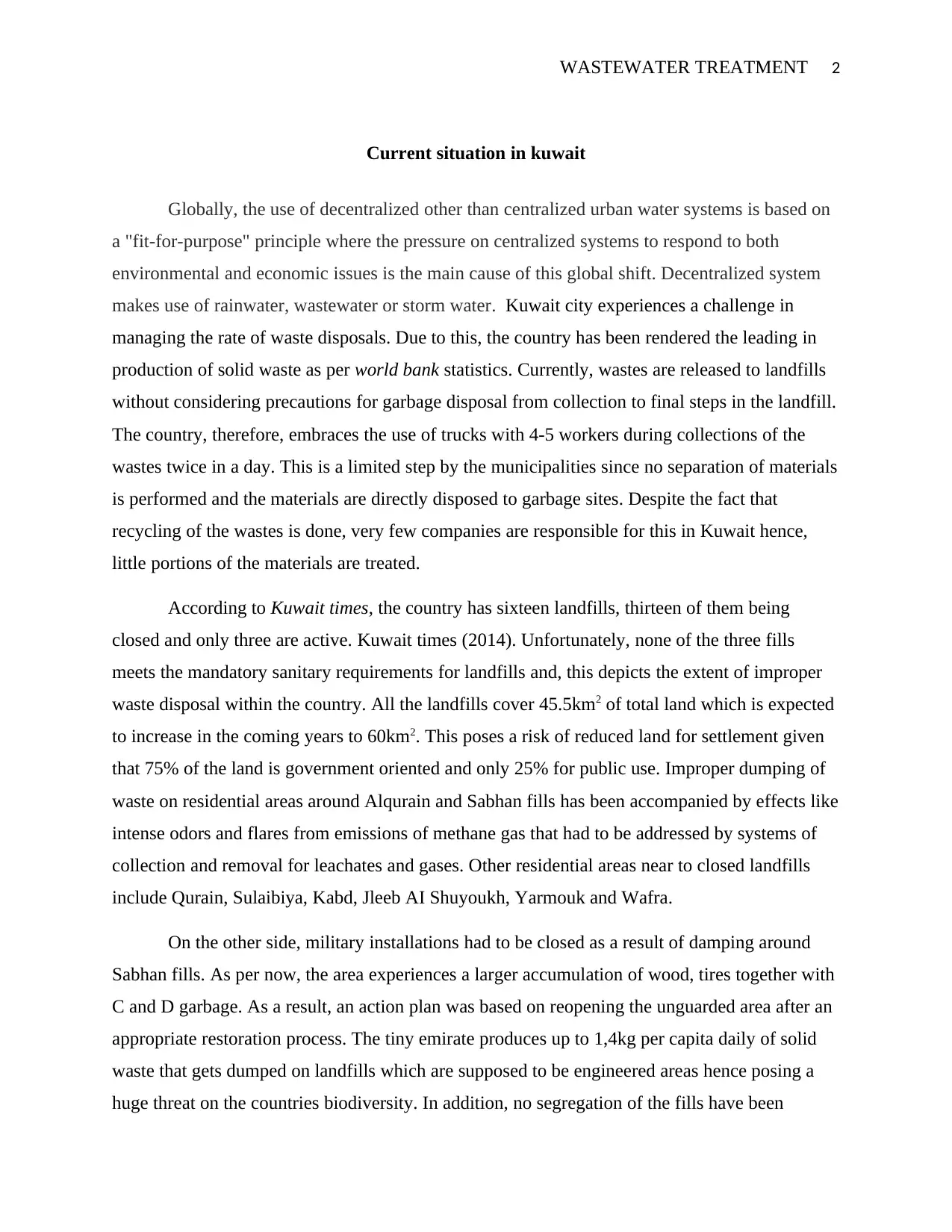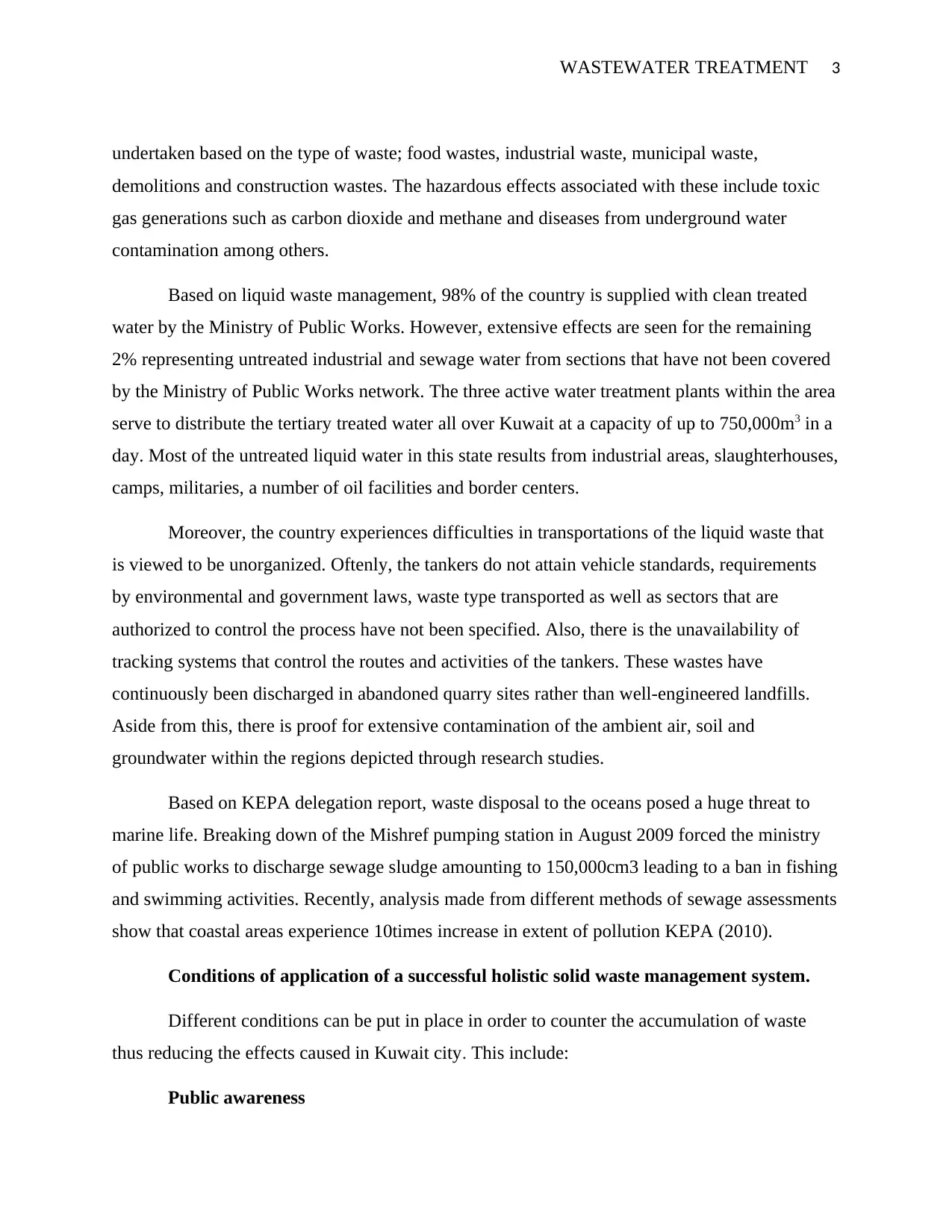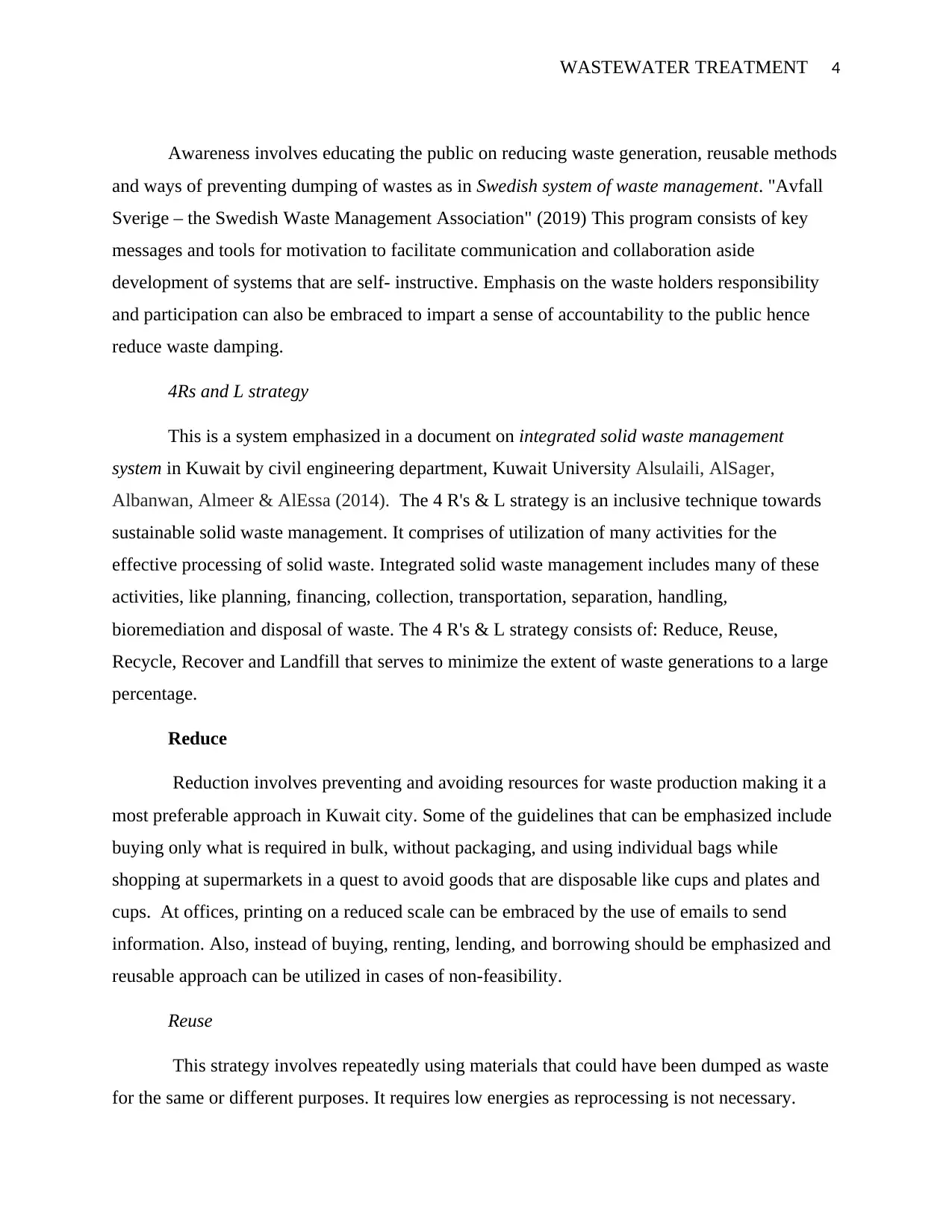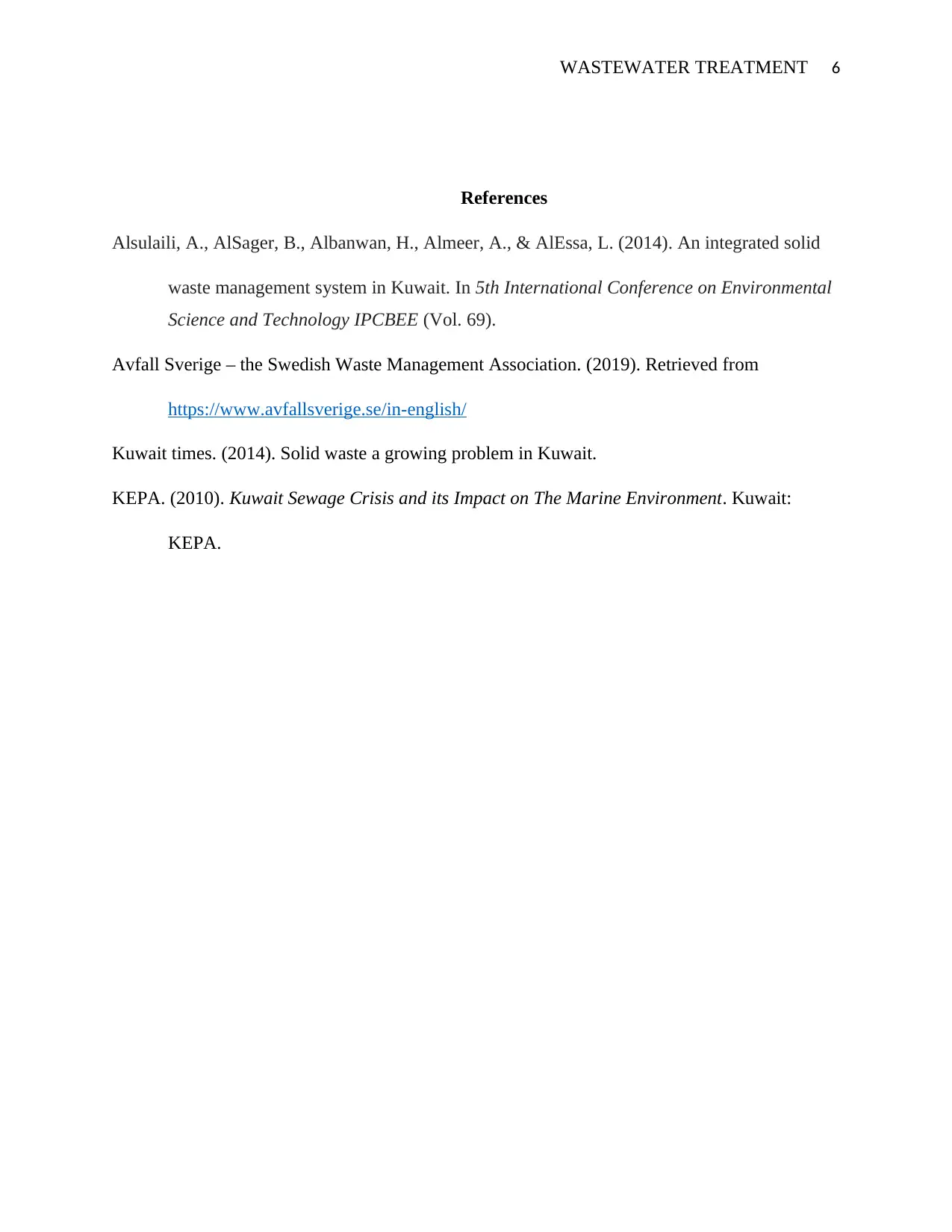Analysis of Wastewater Treatment and Waste Management in Kuwait
VerifiedAdded on 2023/04/12
|6
|1368
|367
Report
AI Summary
This report provides a comprehensive overview of wastewater treatment and waste management challenges in Kuwait. It begins by outlining the current situation, emphasizing the country's struggles with solid waste disposal, including landfill issues and the lack of proper waste segregation. The report highlights the reliance on centralized systems and the environmental and health risks associated with improper waste management practices. It then examines the existing wastewater treatment infrastructure, including the limited coverage of the Ministry of Public Works network and the issues with transporting liquid waste. The report also discusses the impact of waste disposal on marine life and the contamination of air, soil, and groundwater. Furthermore, the report proposes a holistic solid waste management system, focusing on public awareness, the 4Rs and L strategy (Reduce, Reuse, Recycle, Recover, and Landfill), and specific guidelines for each approach. The report concludes by emphasizing the importance of implementing these strategies to mitigate waste accumulation and improve environmental sustainability in Kuwait.

WASTEWATER TREATMENT 1
DECENTRALISED WATER AND WASTEWATER TREATMENT
Name:
Course:
Tutor:
University:
City/state located:
Date:
DECENTRALISED WATER AND WASTEWATER TREATMENT
Name:
Course:
Tutor:
University:
City/state located:
Date:
Paraphrase This Document
Need a fresh take? Get an instant paraphrase of this document with our AI Paraphraser

WASTEWATER TREATMENT 2
Current situation in kuwait
Globally, the use of decentralized other than centralized urban water systems is based on
a "fit-for-purpose" principle where the pressure on centralized systems to respond to both
environmental and economic issues is the main cause of this global shift. Decentralized system
makes use of rainwater, wastewater or storm water. Kuwait city experiences a challenge in
managing the rate of waste disposals. Due to this, the country has been rendered the leading in
production of solid waste as per world bank statistics. Currently, wastes are released to landfills
without considering precautions for garbage disposal from collection to final steps in the landfill.
The country, therefore, embraces the use of trucks with 4-5 workers during collections of the
wastes twice in a day. This is a limited step by the municipalities since no separation of materials
is performed and the materials are directly disposed to garbage sites. Despite the fact that
recycling of the wastes is done, very few companies are responsible for this in Kuwait hence,
little portions of the materials are treated.
According to Kuwait times, the country has sixteen landfills, thirteen of them being
closed and only three are active. Kuwait times (2014). Unfortunately, none of the three fills
meets the mandatory sanitary requirements for landfills and, this depicts the extent of improper
waste disposal within the country. All the landfills cover 45.5km2 of total land which is expected
to increase in the coming years to 60km2. This poses a risk of reduced land for settlement given
that 75% of the land is government oriented and only 25% for public use. Improper dumping of
waste on residential areas around Alqurain and Sabhan fills has been accompanied by effects like
intense odors and flares from emissions of methane gas that had to be addressed by systems of
collection and removal for leachates and gases. Other residential areas near to closed landfills
include Qurain, Sulaibiya, Kabd, Jleeb AI Shuyoukh, Yarmouk and Wafra.
On the other side, military installations had to be closed as a result of damping around
Sabhan fills. As per now, the area experiences a larger accumulation of wood, tires together with
C and D garbage. As a result, an action plan was based on reopening the unguarded area after an
appropriate restoration process. The tiny emirate produces up to 1,4kg per capita daily of solid
waste that gets dumped on landfills which are supposed to be engineered areas hence posing a
huge threat on the countries biodiversity. In addition, no segregation of the fills have been
Current situation in kuwait
Globally, the use of decentralized other than centralized urban water systems is based on
a "fit-for-purpose" principle where the pressure on centralized systems to respond to both
environmental and economic issues is the main cause of this global shift. Decentralized system
makes use of rainwater, wastewater or storm water. Kuwait city experiences a challenge in
managing the rate of waste disposals. Due to this, the country has been rendered the leading in
production of solid waste as per world bank statistics. Currently, wastes are released to landfills
without considering precautions for garbage disposal from collection to final steps in the landfill.
The country, therefore, embraces the use of trucks with 4-5 workers during collections of the
wastes twice in a day. This is a limited step by the municipalities since no separation of materials
is performed and the materials are directly disposed to garbage sites. Despite the fact that
recycling of the wastes is done, very few companies are responsible for this in Kuwait hence,
little portions of the materials are treated.
According to Kuwait times, the country has sixteen landfills, thirteen of them being
closed and only three are active. Kuwait times (2014). Unfortunately, none of the three fills
meets the mandatory sanitary requirements for landfills and, this depicts the extent of improper
waste disposal within the country. All the landfills cover 45.5km2 of total land which is expected
to increase in the coming years to 60km2. This poses a risk of reduced land for settlement given
that 75% of the land is government oriented and only 25% for public use. Improper dumping of
waste on residential areas around Alqurain and Sabhan fills has been accompanied by effects like
intense odors and flares from emissions of methane gas that had to be addressed by systems of
collection and removal for leachates and gases. Other residential areas near to closed landfills
include Qurain, Sulaibiya, Kabd, Jleeb AI Shuyoukh, Yarmouk and Wafra.
On the other side, military installations had to be closed as a result of damping around
Sabhan fills. As per now, the area experiences a larger accumulation of wood, tires together with
C and D garbage. As a result, an action plan was based on reopening the unguarded area after an
appropriate restoration process. The tiny emirate produces up to 1,4kg per capita daily of solid
waste that gets dumped on landfills which are supposed to be engineered areas hence posing a
huge threat on the countries biodiversity. In addition, no segregation of the fills have been

WASTEWATER TREATMENT 3
undertaken based on the type of waste; food wastes, industrial waste, municipal waste,
demolitions and construction wastes. The hazardous effects associated with these include toxic
gas generations such as carbon dioxide and methane and diseases from underground water
contamination among others.
Based on liquid waste management, 98% of the country is supplied with clean treated
water by the Ministry of Public Works. However, extensive effects are seen for the remaining
2% representing untreated industrial and sewage water from sections that have not been covered
by the Ministry of Public Works network. The three active water treatment plants within the area
serve to distribute the tertiary treated water all over Kuwait at a capacity of up to 750,000m3 in a
day. Most of the untreated liquid water in this state results from industrial areas, slaughterhouses,
camps, militaries, a number of oil facilities and border centers.
Moreover, the country experiences difficulties in transportations of the liquid waste that
is viewed to be unorganized. Oftenly, the tankers do not attain vehicle standards, requirements
by environmental and government laws, waste type transported as well as sectors that are
authorized to control the process have not been specified. Also, there is the unavailability of
tracking systems that control the routes and activities of the tankers. These wastes have
continuously been discharged in abandoned quarry sites rather than well-engineered landfills.
Aside from this, there is proof for extensive contamination of the ambient air, soil and
groundwater within the regions depicted through research studies.
Based on KEPA delegation report, waste disposal to the oceans posed a huge threat to
marine life. Breaking down of the Mishref pumping station in August 2009 forced the ministry
of public works to discharge sewage sludge amounting to 150,000cm3 leading to a ban in fishing
and swimming activities. Recently, analysis made from different methods of sewage assessments
show that coastal areas experience 10times increase in extent of pollution KEPA (2010).
Conditions of application of a successful holistic solid waste management system.
Different conditions can be put in place in order to counter the accumulation of waste
thus reducing the effects caused in Kuwait city. This include:
Public awareness
undertaken based on the type of waste; food wastes, industrial waste, municipal waste,
demolitions and construction wastes. The hazardous effects associated with these include toxic
gas generations such as carbon dioxide and methane and diseases from underground water
contamination among others.
Based on liquid waste management, 98% of the country is supplied with clean treated
water by the Ministry of Public Works. However, extensive effects are seen for the remaining
2% representing untreated industrial and sewage water from sections that have not been covered
by the Ministry of Public Works network. The three active water treatment plants within the area
serve to distribute the tertiary treated water all over Kuwait at a capacity of up to 750,000m3 in a
day. Most of the untreated liquid water in this state results from industrial areas, slaughterhouses,
camps, militaries, a number of oil facilities and border centers.
Moreover, the country experiences difficulties in transportations of the liquid waste that
is viewed to be unorganized. Oftenly, the tankers do not attain vehicle standards, requirements
by environmental and government laws, waste type transported as well as sectors that are
authorized to control the process have not been specified. Also, there is the unavailability of
tracking systems that control the routes and activities of the tankers. These wastes have
continuously been discharged in abandoned quarry sites rather than well-engineered landfills.
Aside from this, there is proof for extensive contamination of the ambient air, soil and
groundwater within the regions depicted through research studies.
Based on KEPA delegation report, waste disposal to the oceans posed a huge threat to
marine life. Breaking down of the Mishref pumping station in August 2009 forced the ministry
of public works to discharge sewage sludge amounting to 150,000cm3 leading to a ban in fishing
and swimming activities. Recently, analysis made from different methods of sewage assessments
show that coastal areas experience 10times increase in extent of pollution KEPA (2010).
Conditions of application of a successful holistic solid waste management system.
Different conditions can be put in place in order to counter the accumulation of waste
thus reducing the effects caused in Kuwait city. This include:
Public awareness
⊘ This is a preview!⊘
Do you want full access?
Subscribe today to unlock all pages.

Trusted by 1+ million students worldwide

WASTEWATER TREATMENT 4
Awareness involves educating the public on reducing waste generation, reusable methods
and ways of preventing dumping of wastes as in Swedish system of waste management. "Avfall
Sverige – the Swedish Waste Management Association" (2019) This program consists of key
messages and tools for motivation to facilitate communication and collaboration aside
development of systems that are self- instructive. Emphasis on the waste holders responsibility
and participation can also be embraced to impart a sense of accountability to the public hence
reduce waste damping.
4Rs and L strategy
This is a system emphasized in a document on integrated solid waste management
system in Kuwait by civil engineering department, Kuwait University Alsulaili, AlSager,
Albanwan, Almeer & AlEssa (2014). The 4 R's & L strategy is an inclusive technique towards
sustainable solid waste management. It comprises of utilization of many activities for the
effective processing of solid waste. Integrated solid waste management includes many of these
activities, like planning, financing, collection, transportation, separation, handling,
bioremediation and disposal of waste. The 4 R's & L strategy consists of: Reduce, Reuse,
Recycle, Recover and Landfill that serves to minimize the extent of waste generations to a large
percentage.
Reduce
Reduction involves preventing and avoiding resources for waste production making it a
most preferable approach in Kuwait city. Some of the guidelines that can be emphasized include
buying only what is required in bulk, without packaging, and using individual bags while
shopping at supermarkets in a quest to avoid goods that are disposable like cups and plates and
cups. At offices, printing on a reduced scale can be embraced by the use of emails to send
information. Also, instead of buying, renting, lending, and borrowing should be emphasized and
reusable approach can be utilized in cases of non-feasibility.
Reuse
This strategy involves repeatedly using materials that could have been dumped as waste
for the same or different purposes. It requires low energies as reprocessing is not necessary.
Awareness involves educating the public on reducing waste generation, reusable methods
and ways of preventing dumping of wastes as in Swedish system of waste management. "Avfall
Sverige – the Swedish Waste Management Association" (2019) This program consists of key
messages and tools for motivation to facilitate communication and collaboration aside
development of systems that are self- instructive. Emphasis on the waste holders responsibility
and participation can also be embraced to impart a sense of accountability to the public hence
reduce waste damping.
4Rs and L strategy
This is a system emphasized in a document on integrated solid waste management
system in Kuwait by civil engineering department, Kuwait University Alsulaili, AlSager,
Albanwan, Almeer & AlEssa (2014). The 4 R's & L strategy is an inclusive technique towards
sustainable solid waste management. It comprises of utilization of many activities for the
effective processing of solid waste. Integrated solid waste management includes many of these
activities, like planning, financing, collection, transportation, separation, handling,
bioremediation and disposal of waste. The 4 R's & L strategy consists of: Reduce, Reuse,
Recycle, Recover and Landfill that serves to minimize the extent of waste generations to a large
percentage.
Reduce
Reduction involves preventing and avoiding resources for waste production making it a
most preferable approach in Kuwait city. Some of the guidelines that can be emphasized include
buying only what is required in bulk, without packaging, and using individual bags while
shopping at supermarkets in a quest to avoid goods that are disposable like cups and plates and
cups. At offices, printing on a reduced scale can be embraced by the use of emails to send
information. Also, instead of buying, renting, lending, and borrowing should be emphasized and
reusable approach can be utilized in cases of non-feasibility.
Reuse
This strategy involves repeatedly using materials that could have been dumped as waste
for the same or different purposes. It requires low energies as reprocessing is not necessary.
Paraphrase This Document
Need a fresh take? Get an instant paraphrase of this document with our AI Paraphraser

WASTEWATER TREATMENT 5
Some guidelines that make this a possibility include the use of batteries that are rechargeable,
donation of old items aside reusing materials like vanes and glasses.
Recycle
Recycling involves the formation of new products from reprocessing materials disposed
of as waste thus saves the land that could be covered by landfills, saves natural resources that are
unrenewable aside reducing greenhouse gas emissions. The result is overall reduced air and land
pollution. From these, it is clear that the use of this to curb wastes that can be recycled will
reduce the accumulations in Kuwait city.
Recover
Recover comprises of significant conversions of biodegradable wastes to energy forms or
useable forms like a compost. Here, materials that are rendered non-combustible are taken to
landfills for appropriate disposal that is safe to the environment. Examples of such materials are
metals and glasses. In these case, a sanitary landfill made of systems like leachate and gas
collections, control and removal panels is recommended making it the final step in the 4Rs and L
strategy.
Some guidelines that make this a possibility include the use of batteries that are rechargeable,
donation of old items aside reusing materials like vanes and glasses.
Recycle
Recycling involves the formation of new products from reprocessing materials disposed
of as waste thus saves the land that could be covered by landfills, saves natural resources that are
unrenewable aside reducing greenhouse gas emissions. The result is overall reduced air and land
pollution. From these, it is clear that the use of this to curb wastes that can be recycled will
reduce the accumulations in Kuwait city.
Recover
Recover comprises of significant conversions of biodegradable wastes to energy forms or
useable forms like a compost. Here, materials that are rendered non-combustible are taken to
landfills for appropriate disposal that is safe to the environment. Examples of such materials are
metals and glasses. In these case, a sanitary landfill made of systems like leachate and gas
collections, control and removal panels is recommended making it the final step in the 4Rs and L
strategy.

WASTEWATER TREATMENT 6
References
Alsulaili, A., AlSager, B., Albanwan, H., Almeer, A., & AlEssa, L. (2014). An integrated solid
waste management system in Kuwait. In 5th International Conference on Environmental
Science and Technology IPCBEE (Vol. 69).
Avfall Sverige – the Swedish Waste Management Association. (2019). Retrieved from
https://www.avfallsverige.se/in-english/
Kuwait times. (2014). Solid waste a growing problem in Kuwait.
KEPA. (2010). Kuwait Sewage Crisis and its Impact on The Marine Environment. Kuwait:
KEPA.
References
Alsulaili, A., AlSager, B., Albanwan, H., Almeer, A., & AlEssa, L. (2014). An integrated solid
waste management system in Kuwait. In 5th International Conference on Environmental
Science and Technology IPCBEE (Vol. 69).
Avfall Sverige – the Swedish Waste Management Association. (2019). Retrieved from
https://www.avfallsverige.se/in-english/
Kuwait times. (2014). Solid waste a growing problem in Kuwait.
KEPA. (2010). Kuwait Sewage Crisis and its Impact on The Marine Environment. Kuwait:
KEPA.
⊘ This is a preview!⊘
Do you want full access?
Subscribe today to unlock all pages.

Trusted by 1+ million students worldwide
1 out of 6
Related Documents
Your All-in-One AI-Powered Toolkit for Academic Success.
+13062052269
info@desklib.com
Available 24*7 on WhatsApp / Email
![[object Object]](/_next/static/media/star-bottom.7253800d.svg)
Unlock your academic potential
Copyright © 2020–2025 A2Z Services. All Rights Reserved. Developed and managed by ZUCOL.




